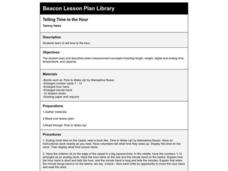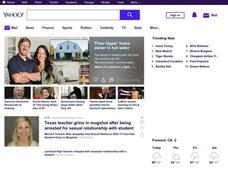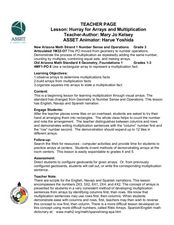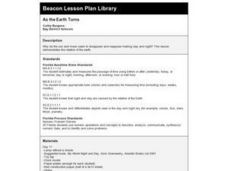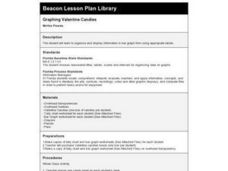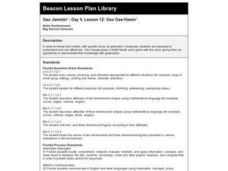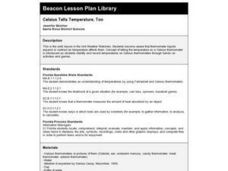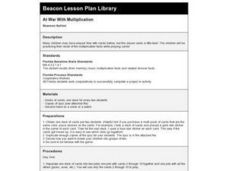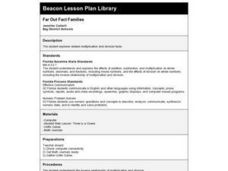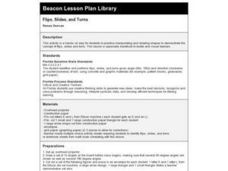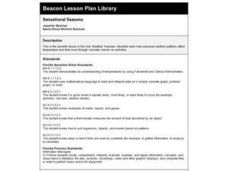Curated OER
Librarian
Students read books, learn about the letter l, and eat pudding all to learn about how to act in a library. In this library lesson plan, students also practice tip toeing around the room.
Curated OER
Firefighters
Students read books, learn about the letter f, and eat ice cream all to learn about firefighters. In this fire fighters lesson plan, students also string beads to look like fire hose and visit a fire house.
Curated OER
Hurray for Arrays and Multiplication
Third graders begin learning about multiplication using arrays. In this multiplication with arrays lesson, 3rd graders interact with tiles on the overhead as they follow the teacher in making arrays. They write multiplication sentences...
Curated OER
Mitten Magic
First graders sort, classify and write about how they sorted their mittens.
Curated OER
Adding and Subtracting Fractions
Second graders use blocks to show the addition and subtraction of fractions with common denominators. They identify the steps in these functions and complete a worksheet.
Curated OER
As the Earth Turns
First graders explore why the sun and moon seems to disappear and reappear creating day and night.
Curated OER
Symmetry Collage
First graders, in groups, studying symmetry, compose collages and bulletin boards.
Curated OER
Graphing Valentine Candies
Fifth graders organize and display information in bar graph form using appropriate labels. Each student receives a box of Valentine heart candies, a worksheet of the tally chart and a worksheet of the bar graph.
Curated OER
Geo Jammin' - Day 4, Lesson 12: Geo Gee-Hawin'
Students review geometry unit content through a vocabulary/word game. They demonstrate understanding using geoboards to answer questions. They work in groups and it's a race to the correct answer.
Curated OER
Celsius Tells Temperature, Too
Second graders become aware that thermometer liquids expand or contract as temperature affects them.
Curated OER
At War With Multiplication
Students play the card game War using basic multiplication facts. They take a multiplication quiz following the game.
Curated OER
Classifying and Constructing Corners
Fifth graders, after seeing Honeycomb examples, complete a Classifying Angles worksheet, Clock worksheet, and Defining Angles worksheet.
Curated OER
Geometry Geopardy
Third graders participate in a game in order to review geometric concepts.
Curated OER
Geometry in Nature
Students examine how the circumference, diameter, and the relationship of Pi of a circle are related. They count the summer rings of a tree to determine its growth.
Curated OER
Drawing Straws
Fourth graders examine the Triangle Inequality Theorem by investigating possible lengths of the sides of a triangle.
Curated OER
My Weather Dial
Students construct a weather dial. In this weather lesson plan, students examine different types of weather and design a weather dial for use during the daily math meeting.
Curated OER
Dynamite Data
Second graders rotate through a variety of stations designed to offer practice in manipulating data. They sort, tally and count items and then create bar graphs, tables, and pie graphs to record their findings.
Curated OER
Far Out Fact Families
Second graders explore related multiplication and division facts. They study the inverse relationship of multiplication and division and engage in a group discussion about families. They complete a web-based lesson which is imbedded in...
Curated OER
Flips, Slides, and Turns
Fifth graders manipulate and draw shapes to demonstrate the concept of flips, slides, and turns using letters and arrows on graph paper.
Curated OER
Sensational Seasons
Second graders explore how seasonal weather patterns affect temperature and their lives.
Curated OER
Double This
Learners change verbal expressions to algebraic equations. They practice the vocabulary of algebraic equations.
Curated OER
Hello, Fractions!
Third graders discover fractions through the use of pattern blocks, literature, website activity and making a fractional pizza.
Curated OER
Three-Dimensional Play Dough
Fourth graders make models of three-dimensional figures and then use these play dough figures to observe and count the vertices, edges, and faces of the figure.


